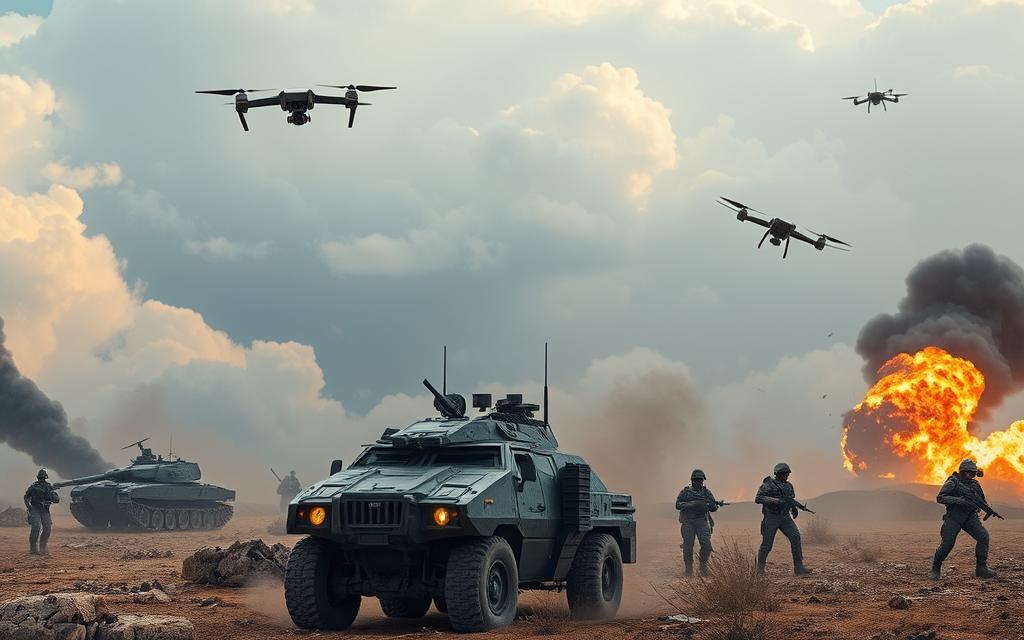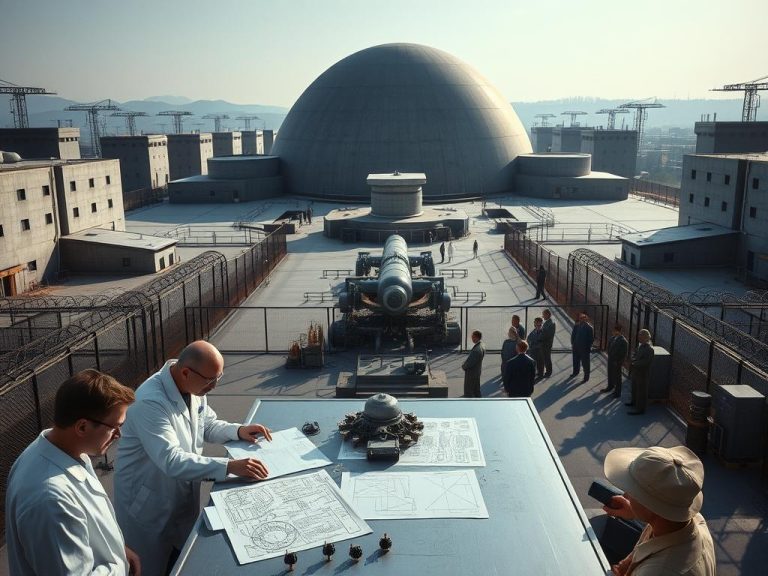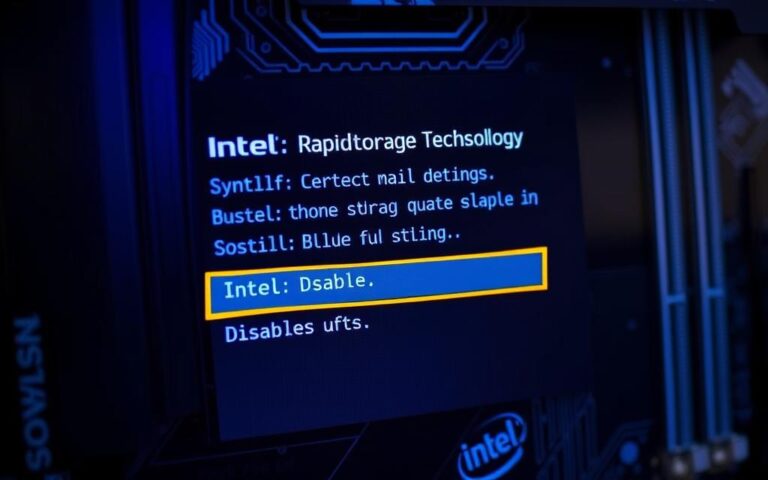How War Drives Technological Innovation: Insights and Impacts
The link between war and technology is complex. War often pushes technology forward. For example, the Internet started in the 1960s with U.S. Department of Defense funding. It was called ARPANET, aiming to improve computer networking.
This project shows how war influences technology and innovation. It has changed how we talk and get information.
War has been a key driver of innovation. It has led to new technologies that change our world. The space race between the U.S. and the Soviet Union is a great example.
This race was driven by fear of missile attacks and the need to be technologically superior. It led to many technological advancements. These were later used for civilian purposes, showing war’s big impact on technology and innovation.
The mix of war, technology, and innovation has big effects. It shapes human history. Looking back, we see war’s big role in pushing innovation forward.
This has big impacts on society. It affects everything from how we communicate to medical breakthroughs and more.
The Historical Relationship Between Warfare and Innovation
Throughout history, warfare has pushed for innovation. This has led to big steps forward in technology. Nations have worked hard to get ahead on the battlefield. This has led to breakthroughs that have changed warfare and civilian life.
The development of radar technology during World War II is a great example. It was key to the Allied victory. Vice Admiral Charles Lockwood also made a big impact on the U.S. submarine force. His work shows how innovation is vital in warfare.
For more on technology and innovation, check out a guide on learning blockchain technology.
Some key examples of innovation driven by warfare include:
- Development of radar technology for military use, which later became key in civilian aviation and weather forecasting.
- Advancements in computing, like ENIAC, which helped create personal computers.
- Improvements in medical treatments and technologies, such as penicillin, first mass-produced during World War II.
These examples show how warfare has driven innovation in technology. This has changed both military and civilian life. Knowing this history helps us see how warfare affects innovation today.
How Does War Affect Technology: Understanding the Mechanisms
The link between war and technology is complex. War often pushes the boundaries of technology. It’s key to grasp how this happens.
Studies reveal that the growth of military tech is shaped by several factors. These include the size of the world’s population and how connected different areas are. Also, major technological breakthroughs play a big role.
A study looked into how military tech evolved in ancient times. It found that the size of a state or its governance didn’t really influence tech growth. Instead, it showed the importance of understanding how war needs drive technology development.
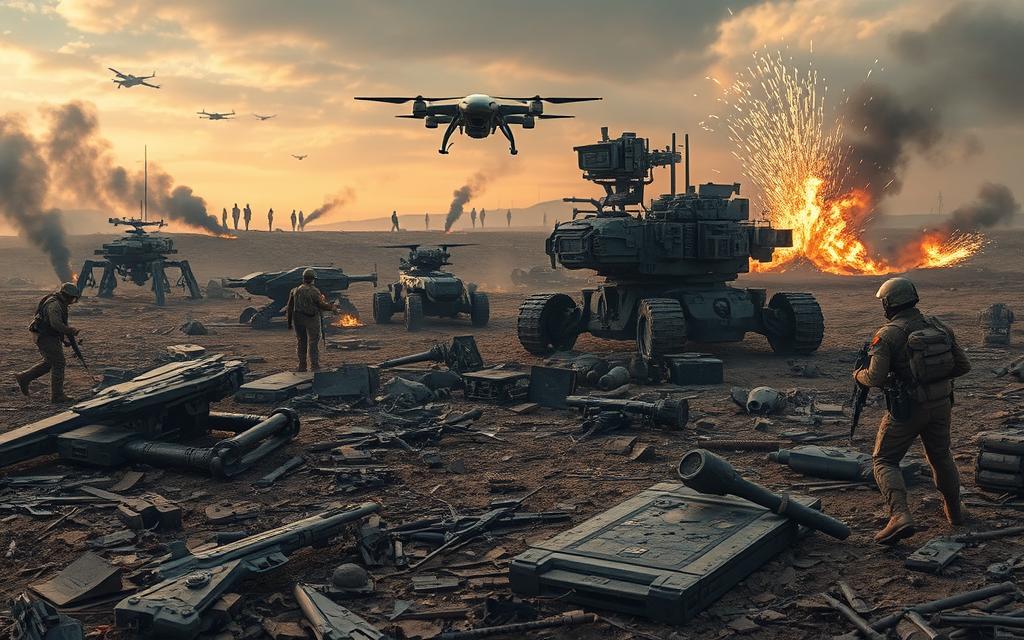
New technologies often come from war needs. For instance, hypersonic weapons and space platforms were developed for military advantage. As Ogarkov noted, modern military power relies heavily on technology, like computers.
Getting to the bottom of how war shapes technology is vital. It helps in innovation and staying competitive in military tech.
Revolutionary Military Innovations That Shaped Civilian Life
Military innovations have always pushed technology forward in our daily lives. They’ve changed everything from our food to our gadgets. Radar technology is a great example. It started in the military but now we have microwave ovens thanks to it.
Computers and aviation are other big examples. World War II’s electronic computers led to our personal computers today. Aviation advances also changed travel, making flights fast and easy around the world.
From Radar to Microwave Ovens
- The development of radar technology during World War II led to the creation of microwave ovens.
- Microwave ovens have become a staple in many households, making it possible to cook food quickly and efficiently.
- This innovation is a testament to the significant impact that military innovations can have on civilian life.
Military Computing to Personal Devices
The start of electronic computers in World War II led to our personal computers today. This change has greatly affected our lives. It lets us quickly access information and talk to others.
Medical Breakthroughs Born from Battlefield Necessity
War has led to many medical breakthroughs, changing healthcare forever. On the battlefield, the need for good treatments has pushed medical tech forward. Penicillin, for example, was created during war and has greatly changed medicine.
Some key medical advancements from the battlefield include:
- Improved surgical techniques, such as those used in facial surgery and burns treatment
- Advances in prosthetic limb technology, enabling amputees to regain mobility and independence
- Development of mobile X-ray units, allowing for more efficient and effective diagnosis and treatment of injuries
These medical breakthroughs have saved many lives on the battlefield. They have also greatly helped civilian healthcare. For example, general anesthesia is now common in medicine, and special hospitals have improved care for certain injuries.
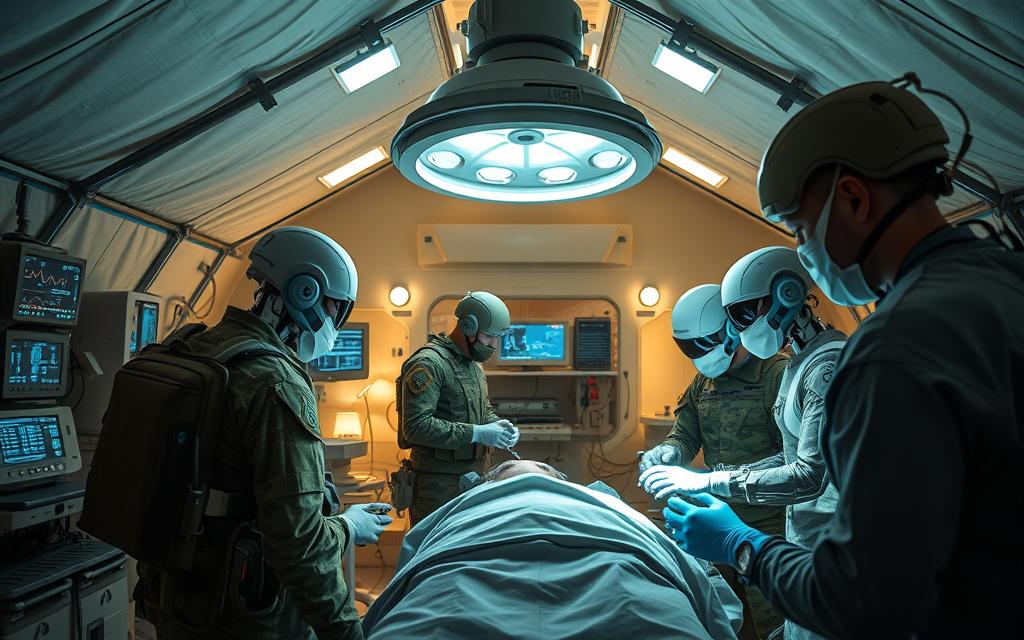
The use of military medical advances in civilian care has lowered death rates and improved care. As we keep innovating in medicine, we must remember the role of battlefield necessity. We also must thank the medical breakthroughs from war for our modern medicine.
| War | Medical Advancement | Impact on Civilian Healthcare |
|---|---|---|
| World War One | Development of the Thomas splint | Improved treatment of fractures and reduced mortality rates |
| Civil War | Use of general anesthesia | Widespread adoption in modern medicine, reducing patient suffering and improving outcomes |
Communication Technologies: From Military Command to Global Connectivity
The growth of communication tech has been shaped by military needs. It focuses on making global connections easier. Radio, the Internet, and satellites have been key in creating today’s communication systems.
A report from Air University shows the Internet’s role. It spreads democracy and violent ideas, helping criminals too. Technologies have changed military and global talks a lot, helping new players use modern tech.
Some big steps in communication tech include:
- Radio tech, over 100 years old, helps both military and civilians.
- Software-defined radios (SDRs) can change with software updates.
- RFID tags track people, things, and vehicles with radio waves.
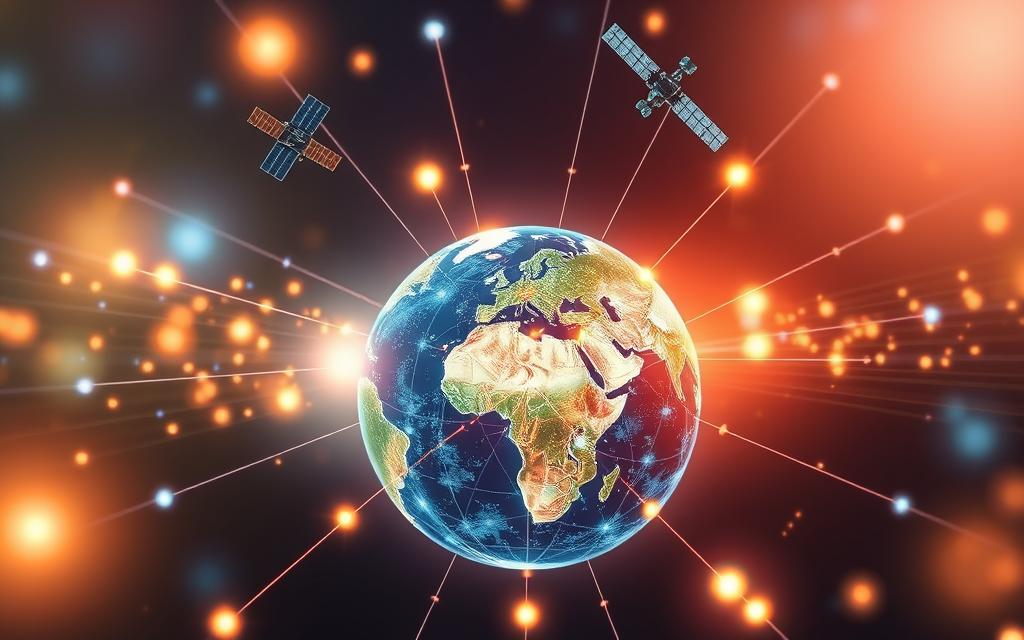
Warfare is changing with new tech users. They use communication to beat more advanced foes. As we connect more, global communication tech will keep growing in importance.
The Space Race: Cold War Competition’s Scientific Legacy
The space race between the United States and the Soviet Union was a key moment in the cold war. It pushed scientific innovation and space technology forward. This rivalry led to big steps in rocket tech, satellite systems, and materials science.
Some key moments were the Soviet Union’s launch of Sputnik 1 in 1957 and the United States’ Explorer 1 in 1958. The Apollo lunar landings were a huge achievement, involving thousands of people.
The space race also spurred the creation of new materials and tech. This includes advanced propulsion systems and lightweight materials. These innovations have greatly influenced science and set the stage for future space missions.
Key achievements of the space race include:
- Launch of Sputnik 1 by the Soviet Union in 1957
- Launch of Explorer 1 by the United States in 1958
- Apollo lunar landing program
- Development of satellite navigation systems
- Advancements in materials science
The space race was a defining moment in the cold war. It drove scientific innovation and competition between the United States and the Soviet Union. The legacy of the space race continues to influence science today, with ongoing research and development in space technology and exploration.
Ethical Considerations in Military-Driven Innovation
As military innovation shapes our world, we must think about the ethical considerations it brings. New technologies in warfare raise big moral and philosophical questions. For example, the use of artificial intelligence and cyber technologies in war has sparked many debates.
One major worry is that these technologies can harm civilians. There’s a balance between controlling these technologies and using their full power. Military ethics demand that we fight for right causes with right means. This makes us question the use of these technologies in war.
Some important ethical thoughts in military innovation are:
- Make sure new technologies are used for good and fair reasons
- Stop the misuse of technologies that could hurt civilians or break human rights
- Create clear rules and laws for making and using new technologies
In recent years, the importance of ethical considerations in military innovation has grown. The US has set AI ethics principles for fair and responsible AI systems. This move has been supported by many countries. As our world changes, we must focus on ethical considerations in military innovation. This way, we can make sure new technologies help everyone, not just a few.
Modern Defence Research and Future Technologies
As we look to the future, research is key in modern defence. Innovation in warfare is vital, with a focus on artificial intelligence, cybersecurity, and autonomous systems. Experts say these technologies will change how we fight.
The use of artificial intelligence in the military is a major focus. Many countries are investing in AI systems. These include machines that can learn and improve, and autonomous vehicles for combat.
Key Areas of Research
- Artificial intelligence in military applications
- Cybersecurity developments to protect against emerging threats
- Autonomous systems research for use in combat zones
These research areas are essential for future technologies in defence. As we move forward, defence research will be critical. It will help countries face the threats of the 21st century. We must keep investing in research to stay ahead.
The future of warfare will be characterized by the increasing use of artificial intelligence, cybersecurity, and autonomous systems, which will significantly impact the nature of conflict.
Conclusion: The Dual Legacy of Wartime Innovation
Looking back, we see how war and technology are linked. The innovation from wartime has a complex legacy. It has brought us many benefits but also raises important questions.
Technologies like radar, the internet, and satellite navigation were born in war. They have changed our lives for the better. Yet, we must think about the harm caused by weapons and the fast pace of new tech.
We need to use the good from wartime innovation but avoid its bad sides. By being careful and ethical, we can make progress in fields like AI and cybersecurity. These advancements can make our world a better place.
FAQ
How has war been a catalyst for technological innovation?
War has often pushed the development of new technologies. Ancient and modern societies have created innovative solutions for warfare. These breakthroughs have changed our world.
Can you provide examples of how military innovations have shaped civilian life?
Military innovations have greatly impacted civilian life. For example, radar technology led to microwave ovens. Advances in computing have also led to personal devices. Aviation progress has helped commercial flight grow.
What is the role of medical breakthroughs in the context of warfare?
Medical innovation has been driven by the need for solutions on the battlefield. Penicillin is a key example. Military and civilian researchers working together have made significant medical progress. These breakthroughs have greatly benefited civilian life.
How has communication technology evolved from military command to global connectivity?
Communication technologies like radio, the Internet, and satellites started in military use. Their evolution has enabled global connectivity. This has changed how we communicate and interact worldwide.
What is the legacy of the space race and its scientific advancements?
The space race, driven by the Cold War, has had a lasting scientific impact. It led to advances in rocket technology, satellite systems, and materials science. These advancements have greatly benefited civilian life.
What are the ethical considerations surrounding military-driven innovation?
The creation of new technologies for warfare raises complex moral questions. It’s important to think deeply about the consequences. We must ensure the benefits of these technologies outweigh the risks.
What are some of the modern defence research and future technologies being developed?
Today, defence research focuses on advanced technologies like artificial intelligence, cybersecurity, and autonomous systems. These innovations will shape future warfare. Their impact on civilian life needs careful consideration and ongoing innovation.

